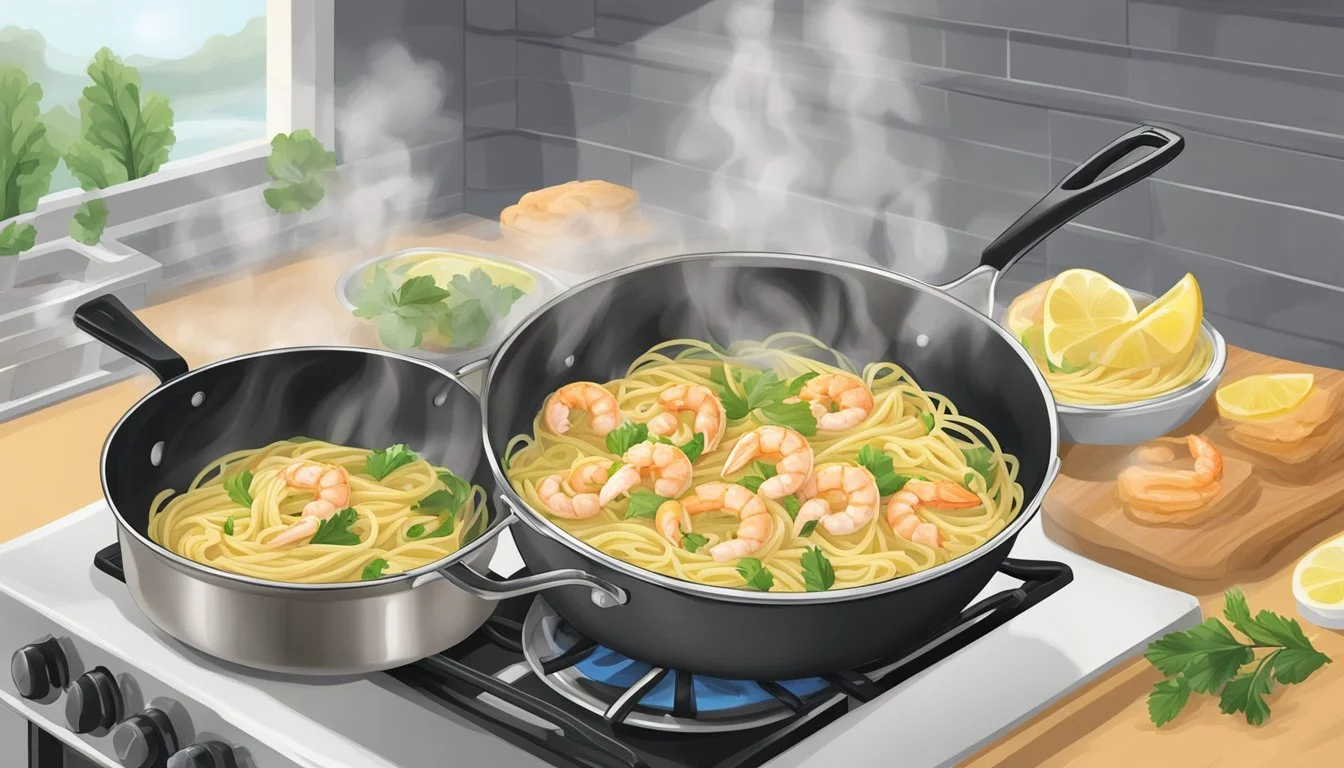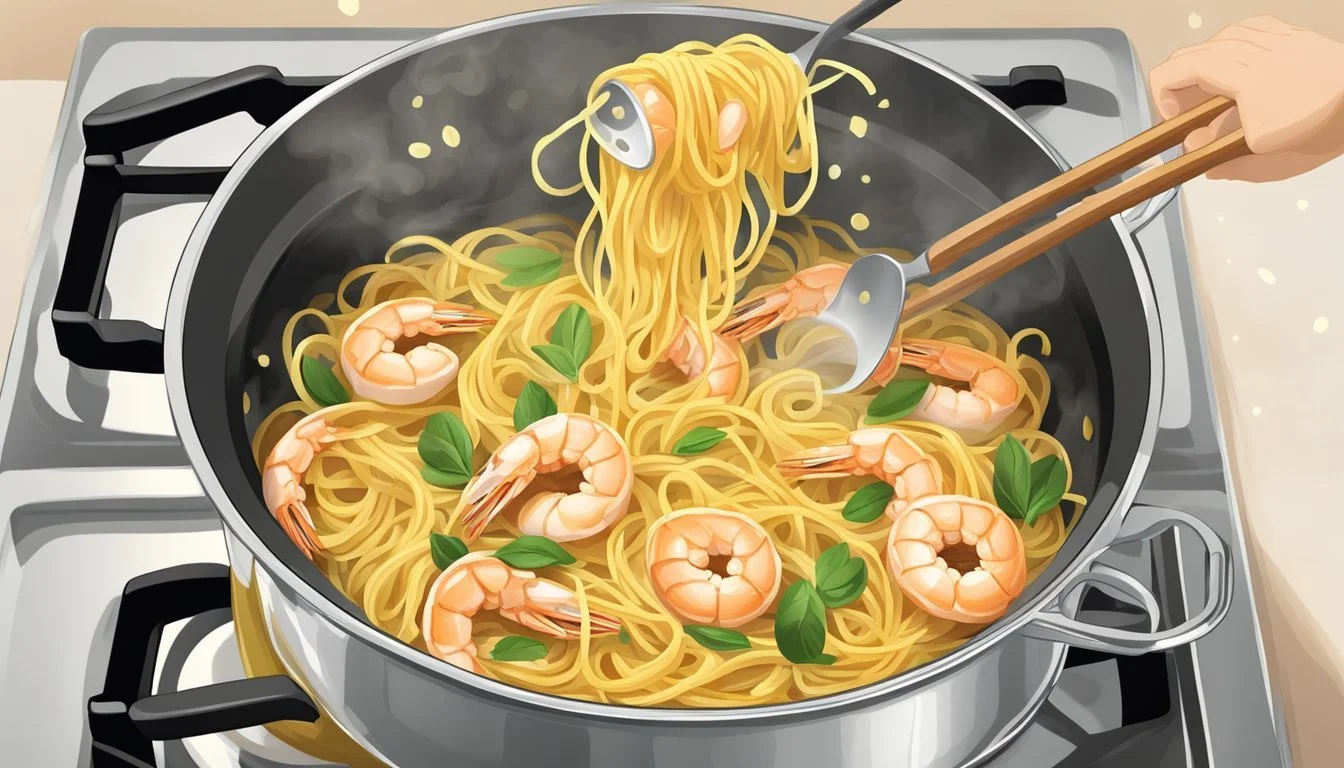Best Way to Reheat Lemon Garlic Shrimp Pasta
Tips for Flavorful, Succulent Results
Reheating lemon garlic (What wine goes well with garlic?) shrimp pasta (What wine goes well with pasta?) while retaining its fresh flavor and succulent shrimp can be challenging. Yet, it is essential to master this to enjoy the leftovers of this delightful pasta dish without compromising its taste and texture. Achieving that perfect balance of a steaming, yet not overcooked, pasta dish requires careful attention to heat and technique.
The key lies in a gentle reheating process that ensures the ingredients are warmed through but do not become dry or rubbery. The zestiness of the lemon and the pungent kick of garlic are delicate flavors that must be preserved during reheating. Moreover, the texture of the shrimp is a crucial aspect of the dish's appeal, necessitating a method that avoids turning these seafood morsels into chewy bites.
Efficient reheating methods will not only save time but also revive the dish as close to its original state as possible. It is important to employ techniques that evenly distribute heat while also incorporating some of the dish's inherent moisture to bring back the vibrant flavors and maintain the integrity of the shrimp and pasta. Whether one chooses to bring new life to their lemon garlic shrimp pasta in the oven or on the stovetop, careful attention to detail will yield a flavorful and appealing meal.
Understanding Reheating Fundamentals
When reheating lemon garlic shrimp pasta, the goal is to restore the dish's original flavor and texture while ensuring that the shrimp remain succulent and the pasta al dente.
The Impact of Heat on Seafood and Pasta Texture
Properly reheating seafood and pasta is crucial. Shrimp, a delicate seafood, can easily become tough when exposed to high heat for extended periods. This is because the proteins within the shrimp firm up excessively, resulting in a rubbery texture. For leftover shrimp pasta, gradual and gentle reheating is essential to maintain the shrimp's succulence.
Cooked pasta, especially if it was originally cooked to al dente, poses its challenges when reheating. Leftover pasta can continue to absorb moisture and swell, leading to a mushy texture if overheated. To prevent overcooking, the pasta should be reheated just until it is warm, which will help retain its firmness and prevent the noodles from becoming too soft.
Benefits of Proper Storage for Leftovers
Proper storage plays a critical role in the quality of leftover shrimp pasta upon reheating. To maintain moisture and flavor, leftovers should be stored in an airtight container. This prevents the pasta from drying out and the shrimp from losing their juiciness. It also helps to keep the garlic and lemon flavors intact, preventing them from becoming muted or altered during storage.
When the time comes to reheat the dish, one will find that appropriately stored leftovers will distribute heat more evenly due to retained moisture, resulting in a more flavorful reheated dish. The key is to maintain a balance, ensuring that the dish stays moist but not to the extent that excess water makes the noodles limp or dilutes the sauce's robust flavors.
Choosing the Right Reheating Method
Selecting an appropriate method for reheating lemon garlic shrimp pasta is crucial to preserving the dish’s flavor and texture. Pasta, be it spaghetti, linguine, or angel hair, requires careful handling to maintain that al dente quality, while shrimp need gentle reheating to stay succulent.
Stovetop Technique
On the stovetop, one should gently reheat lemon garlic shrimp pasta over low to medium heat to avoid overcooking. For pasta like spaghetti or linguine, which may have become dry in the fridge, it's beneficial to add a splash of the initially reserved pasta water or a bit of cream to reintroduce moisture. The process should be brief—just long enough for the ingredients to warm through—while constantly stirring to evenly distribute the heat and prevent sticking.
Oven Heating Process
Using an oven is another method to evenly and gently reheat pasta. Place the lemon garlic shrimp pasta in an oven-safe dish, adding a small amount of pasta water or cream if necessary to keep the pasta moist. Cover the dish with aluminum foil and reheat at a low temperature (around 275°F) until the dish is thoroughly warmed through. This works well for denser types of pasta, ensuring that the dish doesn't dry out.
Microwave Reheating Tips
When under time constraints, a microwave can be the quickest option. To reheat lemon garlic shrimp pasta, distribute the pasta evenly in a microwave-safe dish, integrating a bit of pasta water or cream for moisture. Covering the dish with a microwave-safe lid or plastic wrap can trap steam and prevent the pasta from drying out. Reheat in minimal increments—never more than a minute at a time—stirring in between to help the heat spread uniformly. This method suits any pasta type but requires vigilance to keep the shrimp from becoming rubbery.
Enhancing Flavors During Reheating
When reheating lemon garlic shrimp pasta, the aim is to not only warm the dish but also to invigorate the flavors that may have mellowed in the fridge. It is critical to use the right methods and additives to ensure the pasta remains succulent, and the lemon garlic butter sauce retains its vibrant taste.
Using Complementary Fats
To maintain the silky texture of the sauce, one should consider the use of fats that complement the existing lemon garlic butter sauce. For instance, adding a small pat of butter while reheating can reintroduce richness. Alternatively, a drizzle of extra virgin olive oil can enhance the fragrance and provide a fresh note to the dish, especially when reheated in the oven.
Fats to consider:
Butter: Provides creaminess and rich flavor.
Extra Virgin Olive Oil: Adds a fresh and fruity aroma.
Incorporating Aromatic Ingredients
Introducing additional aromatic ingredients can help revive the pasta's vibrant flavors. Mincing a few fresh garlic cloves and sautéing them before mixing into the pasta boosts the garlic profile. When reheating on a stovetop, one can also soften a finely chopped shallot for an added depth of flavor. The inclusion of Italian parsley, finely chopped, just before serving can offer freshness and a bright color to the dish.
Aromatics to use:
Garlic Cloves: For a stronger garlic punch.
Shallot: Provides a subtle, sweet note.
Italian Parsley: Enhances color and supplies a fresh taste.
Seasoning Adjustments
The final flavor balance can be fine-tuned through careful seasoning adjustments. A light sprinkle of kosher salt can elevate the overall flavor profile without overpowering. Freshly ground black pepper and a squeeze of lemon juice added after reheating may heighten the pasta's zestiness. Furthermore, a modest addition of Parmesan lends a salty umami quality that complements the shrimp and pasta harmoniously.
Seasonings to add:
Kosher Salt: Brings out inherent flavors.
Pepper: Adds a slight kick.
Lemon Juice: Refreshes the palate.
Parmesan: Offers a savory depth.
Presentation and Serving Suggestions
When reheating and serving lemon garlic shrimp pasta, presentation is key to creating an enticing visual appeal, while choosing the right sides and wine can bring balance to the meal, enhancing the flavors.
Plating Techniques for Visual Appeal
The lemon garlic shrimp pasta should be plated with care to showcase the succulent shrimp and the glossy sauce coating the al dente pasta. A simple yet elegant approach is to twirl a serving fork in the pasta to create height on the plate. The shrimp should then be strategically placed on top with some pieces slightly nestled into the pasta to display their pink and tender appearance. For a touch of color contrast, sprinkle vibrant chopped parsley or basil over the top. A few halved cherry tomatoes can be added for an additional burst of color.
Complementing Sides to Balance the Meal
To accompany this Italian classic, a selection of sides can offer a palate-cleansing contrast and enhance the overall dining experience.
Vegetables: Steamed broccoli, asparagus, or green beans provide a crunchy and fresh counterpoint to the richness of the pasta.
Green Salad: A simple green salad dressed with a light vinaigrette complements the dish without overpowering the delicate flavors of the lemon and garlic.
Garlic Bread: A slice of warm, crispy garlic bread is perfect for mopping up any remaining sauce and adds a satisfying textural component.
Wine Pairing
When selecting a wine to serve with lemon garlic shrimp pasta, opt for a dry white wine that can cut through the richness while accentuating the lemon's citrus notes.
Pinot Grigio: A crisp and refreshing choice, this wine pairs well with the light seafood flavors and can stand up to the boldness of the garlic.
Other White Wines: A variety of other dry white wines, including unoaked chardonnays or sauvignon blanc, can also complement the dish effectively by highlighting its bright and aromatic profile.
Additional Tips and Tricks
When reheating lemon garlic shrimp pasta, one should aim to maintain the delicate texture of both the shrimp and the pasta while restoring their flavorful essence. This section provides specific advice to ensure these components remain as tantalizing as freshly prepared.
Restoring Pasta to Al Dente State
To revive pasta into an al dente texture, consider quickly dipping it in boiling water. This process, termed "flash boiling," involves submerging the dried spaghetti for just a minute, then immediately draining and adding to the main dish. Always save a cup of pasta water to adjust the sauce consistency if necessary.
Preventing Common Reheating Mistakes
Avoiding overcooking is paramount. For large shrimp, gently reheat them in a skillet with a dash of chicken broth to retain moisture without turning rubbery. Limit the heat to low and cover for the last minute to steam. With frozen shrimp, ensure they are fully thawed and patted dry to prevent watering down the dish during reheating.
Leveraging Leftover Ingredients
Utilize any leftover ingredients such as fresh garlic, lemon zest, and crushed red pepper flakes to refresh the flavors after reheating. A sprinkle of Parmesan or Pecorino cheese, a squeeze of fresh lemon juice, and a touch of black pepper can elevate the dish. These pantry staples restore vibrancy and can compensate for any flavor loss due to refrigeration.



